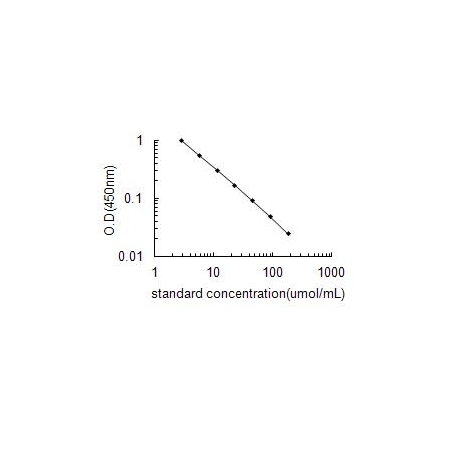Creatinine ELISA Kit
Referência OKEH02617
Tamanho : 96Wells
Marca : Aviva Systems Biology
| Predicted Species Reactivity | All Species | ||||||||||||||||||||||
|---|---|---|---|---|---|---|---|---|---|---|---|---|---|---|---|---|---|---|---|---|---|---|---|
| Application | ELISA-Comp | ||||||||||||||||||||||
| ELISA Kit Detection Method | Colorimetric, OD 450 nm | ||||||||||||||||||||||
| ELISA Kit Duration | ~ 3 Hours | ||||||||||||||||||||||
| ELISA Kit Principle | Aviva Systems Biology Creatinine ELISA Kit (OKEH02617) is based on a competitive enzyme immunoassay technique. The microtiter well-plate in this kit has been pre-coated with an anti-Creatinine antibody. Sample or standards are added to the wells along with a fixed quantity of biotinylated Creatinine and incubated. The Creatinine found in the sample or standards competes with the biotinylated Creatinine for limited binding sites on the immobilized anti-Creatinine antibody. Excess unbound biotinylated Creatinine and sample or standard Creatinine is washed from the plate. Avidin-HRP conjugate is added, incubated and washed. An enzymatic reaction is then produced through the addition of TMB substrate which is catalyzed by the immobilized HRP to generate a blue color product that changes yellow after adding acidic stop solution. The density of yellow coloration is measured by reading the absorbance at 450 nm which is quantitatively proportional to the amount of biotinylated Creatinine captured in the well and inversely proportional to the amount of Creatinine which was contained in the sample or standard. | ||||||||||||||||||||||
| ELISA Kit Range | 2.8-180umol/L | ||||||||||||||||||||||
| ELISA Kit Reproducibility | Mean Intra-assay CV%: < 5.5% (n = 20) Mean Inter-assay CV%: < 8.2% (n = 20) | ||||||||||||||||||||||
| ELISA Kit Component |
| ||||||||||||||||||||||
| Additional Information | Target Abbr: Cr Target Name: Creatinine | ||||||||||||||||||||||
| :: | Pubchem: 588 | ||||||||||||||||||||||
| :: | Chemical formula: C4H7N3O | ||||||||||||||||||||||
| Reconstitution and Storage | Store as indicated in product manual. | ||||||||||||||||||||||
| Sample Type | Serum, plasma, tissue homogenates, cell culture supernatants and other biological fluids | ||||||||||||||||||||||
| Sensitivity | 1.4umol/ml | ||||||||||||||||||||||
| Specificity | Natural and recombinant General Creatinine | ||||||||||||||||||||||
| Assay Info | Assay Methodology: Quantitative Competitive ELISA |
| Alias Symbols | Cr, Creatinine, Cr |
|---|---|
| Protein Name | Creatinine |
| Description of Target | Measuring serum creatinine is a simple test and it is the most commonly used indicator of renal function. In the United States, creatinine is typically reported in mg/dL, whereas, in Canada and a few European countries, umol/litre may be used. 1 mg/dL of creatinine is 88.4 umol/L. The typical human reference ranges for serum creatinine are 0.5 to 1.0 mg/dL (about 45-90 umol/L) for women and 0.7 to 1.2 mg/dL (60-110 umol/L) for men. While a baseline (medicine) serum creatinine of 2.0 mg/dL (150 umol/L) may indicate normal kidney function in a male body builder, a serum creatinine of 1.2 mg/dL (110 umol/L) can indicate significant renal disease in an elderly female. for male reference range are 60-120 umol/L and for female it is 50-110 umol/L. Creatinine is a break-down product of creatine phosphate in muscle, and is usually produced at a fairly constant rate by the body (depending on muscle mass). |




